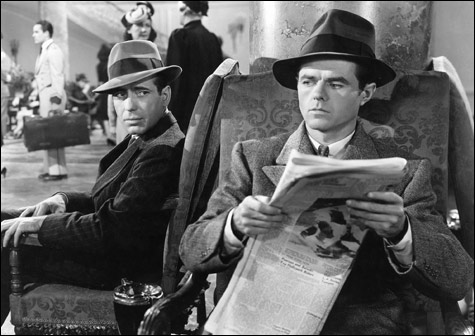Film noir and the Production Code at the MFA
By STEVE VINEBERG | May 27, 2009

THE MALTESE FALCON: How did Elisha Cook Jr.’s homosexual Wilmer sneak past Joseph Breen’s watchdogs? |
| “Film Noir and the Production Code” | Museum of Fine Arts: June 4-27 |
"At heart, film noir was Code splintering. The dark genre sabotaged the sunny optimism of Hollywood cinema with a gloomy weltanschauung smuggled in by foreign-born agents like Fritz Lang, Billy Wilder, Robert Siodmak, Otto Preminger. . . . Film noir was the un-American activity in Hollywood that the U.S. Congress should really have been investigating."That's Brandeis American-studies professor Thomas Doherty writing in Hollywood's Censor: Joseph I. Breen and the Production Code Administration. The Production Code, Hollywood's notorious self-censorship program, was instituted by the Motion Picture Producers and Distributors of America in 1930, but it didn't go into effect till 1934, when it was administered by Joseph I. Breen. The Code (popularly known as the Hays Code, after its original, lame-duck supervisor, Will B. Hays) severely restricted Hollywood's portrayal of sex and violence, but it grew more flexible in the years following World War II, and by the mid '60s it had become obsolete. (The MPAA ratings system was its official replacement.) The seven movies screening in the Museum of Fine Arts' "Film Noir and the Production Code" series this month show how film noir — that most brutal and anti-social of genres, the embodiment of the forbidden fruit the Production Code framers were afraid movies would tempt audiences to covet — challenged the Code in the '40s and '50s.
Not all these films are true noirs: the latest one, ANATOMY OF A MURDER (1959), is a courtroom drama, and GILDA (1946) is a cut-rate romantic melodrama. Both were, I presume, included because they offer femme fatales: the title character in Gilda, played by Rita Hayworth (who, in the film's highlight, performs "Put the Blame on Mame"), and Laura Manion (Lee Remick), the flirtatious wife of the soldier (Ben Gazzara) in Anatomy of a Murder whom Jimmy Stewart's homespun small-town lawyer defends for murdering the man who had beaten and raped her. There are four classic noirs: THE MALTESE FALCON (1941), DOUBLE INDEMNITY (1944), THE BIG SLEEP (1946), and TOUCH OF EVIL (1958). And there's perhaps the most bizarre of all '50s noirs, KISS ME DEADLY (1955), which was adapted from a Mickey Spillane novel. In John Huston's The MalteseFalcon, a number of people die for "the stuff dreams are made of," a gold statuette that keeps eluding its obsessed, ruthless seekers. In Kiss Me Deadly, the object of everyone's desire, known as "the great whatsit," turns out to be a Cold War version of Pandora's box.
 Related
Related:
Mixed media, Review: L.A. Noire, Portland Stage goes noir, More 
- Mixed media
Film noir has been a running theme in composer/pianist Ran Blake's work since the beginning of his career — his very first album, The Newest Sound Around (RCA, 1962), with singer Jeanne Lee, began with David Raskin's theme to Otto Preminger's Laura .
- Review: L.A. Noire
When a game comes saddled with as much hype as L.A. Noire , one is tempted to judge it by an unattainable standard.
- Portland Stage goes noir
Dead guys, mysterious dames, mobsters, dirty cops, and a handsome array of handguns are all in a night's work for Philip Marlowe, novelist Raymond Chandler's quintessential LA private eye.
- Review: Elena
Andrei Zvyagintsev's film, a Special Jury Prize winner at Cannes 2011, becomes more than a domestic melodrama: a grim, effective allegory of the daily whirl in Putinland.
- Monster man and more
James Whale's career as a purveyor of marvelous film entertainments was brief.
- Moral minority
“It’s incorrect to assert that traditional Hollywood films always have happy endings,” film historian Thomas Doherty once noted on a panel I attended.
- Hardboiled hub
When I was growing up in Roslindale a few decades back — among tribes of ignorant, second-generation immigrant kids whose favorite words began with “f” and “n” and who liked to torture small animals and beat up small children before they moved on to their future vocations as petty criminals, dead dope users, or real-estate agents.
- Less

 Topics
Topics:
Features
, Entertainment, Movies, Howard Hawks, More  , Entertainment, Movies, Howard Hawks, Martha Vickers, Philip Marlowe, Barbara Stanwyck, Mary Astor, Mercedes McCambridge, Sam Spade, Lee Remick, Less
, Entertainment, Movies, Howard Hawks, Martha Vickers, Philip Marlowe, Barbara Stanwyck, Mary Astor, Mercedes McCambridge, Sam Spade, Lee Remick, Less 